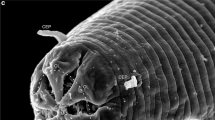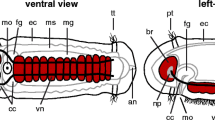Abstract
Protein kinases play important roles in various cellular interactions underlying metazoan development. To complement existing analyses of protein kinase function in the development of members of the three phyla, Chordata, Arthropoda, and Nematoda, we have begun to examine the cell-and tissue-specific localization of protein kinases in another metazoan phylum, the Annelida. For this purpose, we used the polymerase chain reaction to amplify putative protein kinase catalytic domain cDNAs from the medicinal leech, Hirudo medicinalis. This strategy allowed us to identify 11 cytoplasmic and receptor tyrosine kinase catalytic domains, and 2 cytoplasmic serine/threonine kinase catalytic domains. Using these cDNAs as probes for nonradioactive whole-mount in situ hybridization, we examined the embryonic expression pattern of each of the corresponding putative kinase mRNAs. As has been found in other species, most of the Hirudo protein kinase mRNAs were expressed in a highly specific manner in certain embryonic cells and tissues. We found both neuron-and glia-specific kinases within the nervous system, as well as kinases expressed in non-nervous tissues, such as the haemocoelomic, muscular, and excretory systems. These kinase cDNAs encode proteins likely to be critical for proper development, and can be used as cell-and tissue-specific histological probes for the analysis of Hirudo embryogenesis.
Similar content being viewed by others
References
Aroian RV, Sternberg PW (1991) Multiple functions of let-23, a Caenorhabditis elegans receptor tyrosine kinase gene required for vulval induction. Genetics 128:251–267
Bennett MK, Kennedy MB (1987) Deduced primary structure of the β subunit of brain type II calcium/calmodulin-dependent protein kinase determined by molecular cloning. Proc Natl Acad Sci USA 84:1794–1798
Bosch TCG, Unger TF, Fisher DA, Steele RE (1989) Structure and experession of STK, a src-related gene in the simple metazoan Hydra attenuata. Mol Cell Biol 9:4141–4151
Boulton TG, Nye SH, Robbins DJ, lp NY, Radziejewska E, Morgenbesser SD, DePinho RA, Panayotatos N, Cobb MH, Yancopoulos GD (1991) ERKs: a family of protein-serine/threonine kinases that are activated and tyrosine phosphorylated in response to insulin and NGF. Cell 65:663–675
Chan A M-L, King HW, Deakin EA, Tempest PR, Hilkens J, Kroezen V, Edwards DR, Wills AJ, Brookes P, Cooper CS (1988) Characterization of the mouse met proto-oncogene. Oncogene 2:593–599
Cho K-O, Wall JB, Pugh PC, Ito M, Mueller SA, Kennedy MB (1991) The α subunit of type II Ca2+/calmodulin-dependent protein kinase is highly conserved in Drosophila. Neuron 7:439–450
Coggeshall RE, Fawcett DW (1964) The fine structure of the central nervous system of the leech, Hirudo medicinalis. J Neurophysiol 27:229–289
Coussens L, Van Beveren C, Smith D, Chen E, Mitchell RL, Isacke CM, Verma IM, Ullrich A (1986) Structural alteration of viral homologue of receptor proto-oncogene fms at carboxyl terminus. Nature 320:277–280
Derosa YS, Friesen W O (1981) Morphology of leech sensilla: observations with the scanning electron microscope. Biol Bull 160:383–393
DiRenzo MF, Bertolotto A, Olivero M, Putzolo P, Crepaldi T, Schiffer D, Pagni CA, Comoglio PM (1993) Selective expression of the Met/HGF receptor in human central nervous system microglia. Oncogene 8:219–222
Ebina Y, Ellis L, Jarnagin K, Edery M, Graf L, Clauser E, Ou J-H, Masiarz F, Kan YW, Goldfine ID, Roth RA, Rutter WJ (1985) The human insulin receptor cDNA: the structural basis for hormone-activated transmembrane signaling. Cell 40:747–758
Erondu NE, Kennedy MB (1985) Regional distribution of type II calcium/calmodulin-dependent protein kinase in rat brain. J Neurosci 5:3270–3277
Fernandez J, Stent GS (1982) Embryonic development of the hirudinid leech Hirudo medicinalis: structure, development and segmentation of the germinal plate. J Embryol 72:71–96
Flaster MS, Zipser B (1987) The macroglial cells of the leech are molecularly heterogeneous. J Neurosci 17:176–183
Glazer L, Shilo B-Z (1991) The Drosophila FGF-R homolog is expressed in the embryonic tracheal system and appears to be required for directed tracheal cell extension. Genes Dev 5:697–705
Gregory RJ, Kammermeyer KL, Vincent WS III, Wadsworth SG (1987) Primary sequence and developmental expression of a novel Drosophila melanogaster src gene. Mol Cell Biol 7:2119–2127
Hanks SK, Quinn AM (1991) Protein kinase catalytic domain sequence database: identification of conserved features of primary structure and classification of family members. In: Hunter T, Sefton BM (eds) Methods in enzymology, vol 200. Academic Press, New York, pp 38–62
Hanks SK, Quinn AM, Hunter T (1988) The protein kinase family: conserved features and deduced phylogeny of the catalytic domains. Science 241:42–52
Harant H, Grasse P-P (1959) Classe des annelides achetes ou hirudinees ou sangsues. In: Grasse P-P (ed) Traite de zoologie anatomie-systomatique biologie, vol 5, part 1 Masson, Paris
Hunter T (1991) Protein kinase classification. In: Hunter T, Sefton BM (eds) Methods in enzymology, vol 200. Academic Press, New York, pp 3–37
Katzen AL, Kornberg T, Bishop JM (1991) Expression during Drosophila development of DER, a gene related to erbB-1 and neu: correlations with mutant phenotypes. Dev Biol 145:287–301
Klämbt C, Glazer L, Shilo B-Z (1992) breathless, a Drosophila FGF receptor homolog, is essential for migration of tracheal and specific midline glial cells. Genes Dev 6:1668–1678
Lai C, Lemke G (1991) An extended family of protein-tyrosine kinase genes differentially expressed in the vertebrate nervous system. Neuron 6:691–704
Lin CR, Kapiloff MS, Durgerian S, Tatemoto K, Russo AF, Hanson P, Schulman H, Rosenfeld MG (1987) Molecular cloning of a brain-specific calcium/calmodulin-dependent protein kinase. Proc Natl Acad Sci USA 84:5962–5966
Macagno ER (1980) Number and distribution of neurons in leech segmental ganglia. J Comp Neurol 190:283–302
Macagno ER, Gao W-Q, Baptista CA, Passani MB (1990) Competition or inhibition? Developmental strategies in the establishment of peripheral projections by leech neurons. J Neurobiol 21:107–119
Maness PF, Cox ME (1992) Protein tyrosine kinases in nervous system development. Sem Cell Biol 3:117–126
Mansukhani A, Moscatelli D, Talarico D, Levytska V, Basilico C (1990) A murine fibroblast growth factor (FGF) receptor expressed in CHO cells is activated by basic FGF and Kaposi FGF. Proc Natl Acad Sci USA 87:4378–4382
Matthews W, Jordan CT, Gavin M, Jenkins NA, Copeland NG, Lemischka IR (1991) A receptor tyrosine kinase cDNA isolated from a population of enriched primitive hematopoietic cells and exhibiting close genetic linkage to c-kit. Proc Natl Acad Sci USA 88:9026–9030
Nardelli-Haefliger D, Shankland M (1992) Lox2, a putative leech segment identity gene, is expressed in the same segmental domain in different stem cell lineages. Development 116:697–710
Nishida Y, Hata M, Nishizuka Y, Rutter WJ, Ebina Y (1986) Cloning of a Drosophila cDNA encoding a polypeptide similar to the human insulin receptor precursor. Biochem Biophys Res Commun 141:474–481
Park M, Dean M, Kaul K, Braun MJ, Gonda MA, Vande Woude G (1987) Sequence of MET protooncogene cDNA has features characteristic of the tyrosine kinase family of growth-factor receptors. Proc Natl Acad Sci USA 84:6379–6383
Sahley CL (1987) Dishabituation and sensitization of the touchelicited shortening reflex in the leech, Hirudo medicinalis (abstract). Soc Neurosci Abstr 13:615
Sawyer RT (1986) Leech biology and behavior. Anatomy, physiology, and behavior, vol 1. Clarendon Press, Oxford
Shibuya M, Yamaguchi S, Yamane A, Ikeda T, Tojo A, Matsushime H, Sato M (1990) Nucleotide sequence and expression of a novel human receptor-type tyrosine kinase gene (flt) closely related to the fms family. Oncogene 5:519–524
Shilo B-Z (1992) Roles of receptor tyrosine kinases in Drosophila development. FASEB J 6:2915–2922
Silva AJ, Paylor R, Wehner JM, Tonegawa S (1992a) Impaired spatial learning in alpha-calmodulin-calmodulin kinase II mutant mice. Science 257:206–211
Silva AJ, Stevens CF, Tonegawa S, Wang Y (1992b) Deficient hippocampal long-term potentiation in alpha-calcium-calmodulin kinase Il mutant mice. Science 257:201–206
Simon MA, Drees B, Kornberg T, Bishop JM (1985) The nucleotide sequence and the tissue-specific expression of Drosophila c-src. Cell 42:831–840
Stark KL, McMahon JA, McMahon AP (1991) FGFR-4, a new member of the fibroblast growth factor receptor family, expressed in the definitive endoderm and skeletal muscle lineages of the mouse. Development 113:641–651
Steedman JG, Landreth GE (1989) Expression of pp60c-src in adult and developing rat central nervous system. Dev Brain Res 45:161–167
Thorey IS, Zipser B (1991) The segmentation of the leech nervous system is prefigured by myogenic cells at the embryonic midline expressing a muscle-specific matrix protein. J Neurosci 11:1786–1799
Tobimatsu T, Kameshita I, Fujisawa H (1988) Molecular cloning of the cDNA encoding the third polypeptide (γ) of brain calmodulin-dependent protein kinase II. J Biol Chem 263:16082–16086
Ullrich A, Bell JR, Chen EY, Herrera R, Petruzzelli LM, Dull TJ, Gray A, Coussens L, Liao Y-C, Tsubokawa M, Mason A, Seeburg PH, Grunfeld C, Rosen O M, Ramachandran J (1985) Human insulin receptor and its relationship to the tyrosine kinase family of oncogenes. Nature 313:756–761
Wadsworth SC, Muckenthaler FA, Vincent WS III (1990) Differential expression of alternate forms of a Drosophila src protein during embryonic and larval tissue differentiation. Dev Biol 138:296–312
Wilks AF (1989) Two putative protein-tyrosine kinases identified by application of the polymerase chain reaction. Proc Natl Acad Sci USA 86:1603–1607
Author information
Authors and Affiliations
Rights and permissions
About this article
Cite this article
Nitabach, M.N., Macagno, E.R. Cell-and tissue-specific expression of putative protein kinase mRNAs in the embryonic leech, Hirudo medicinalis . Cell Tissue Res 280, 479–489 (1995). https://doi.org/10.1007/BF00318352
Received:
Accepted:
Issue Date:
DOI: https://doi.org/10.1007/BF00318352




